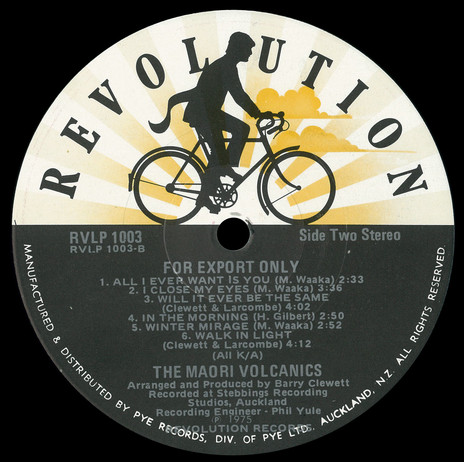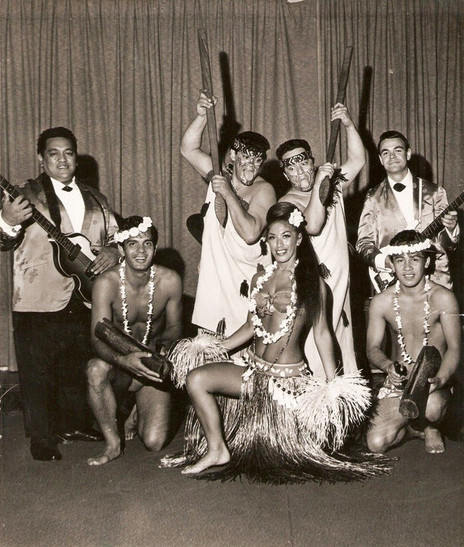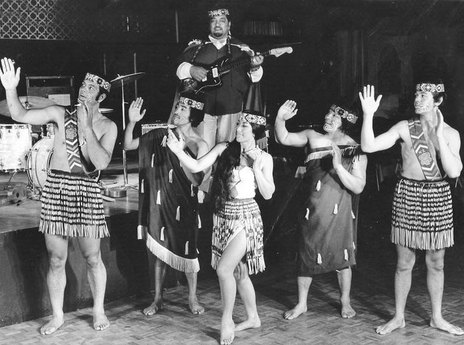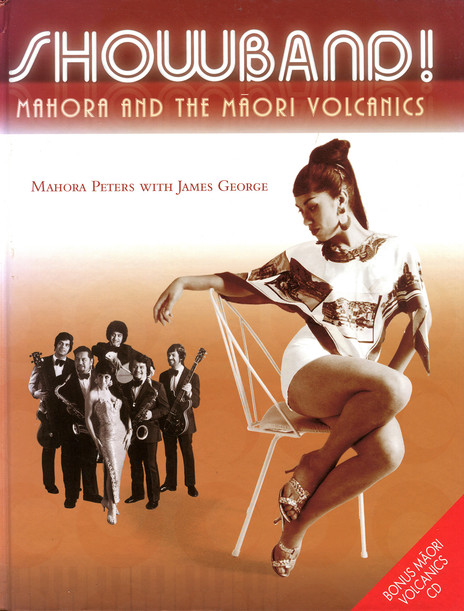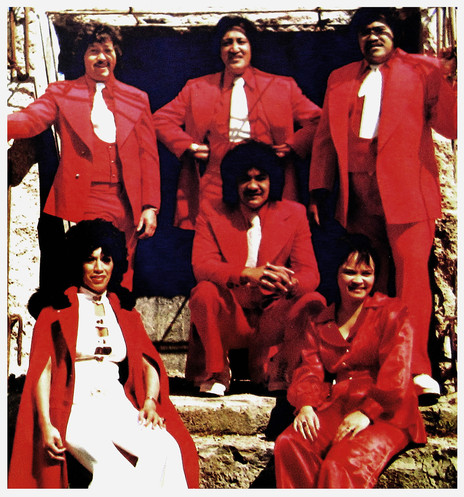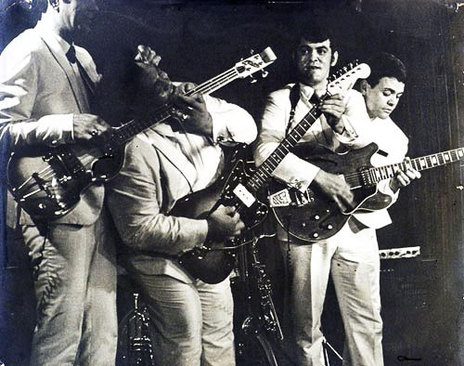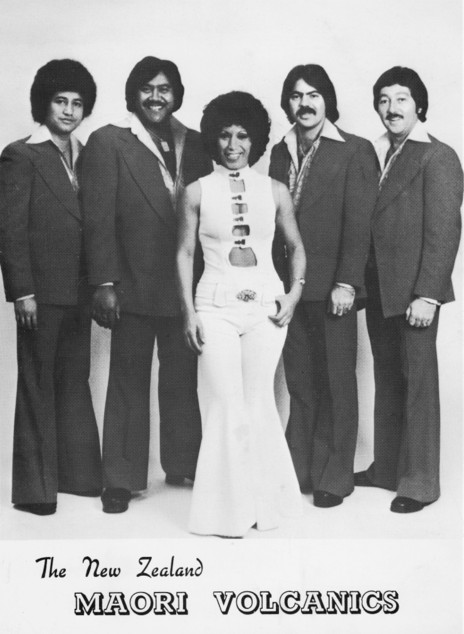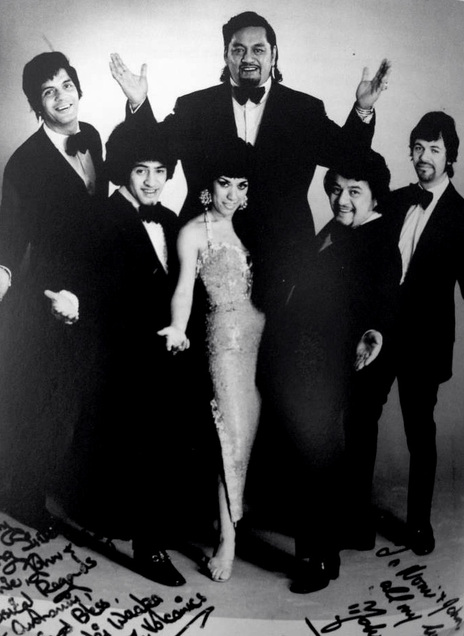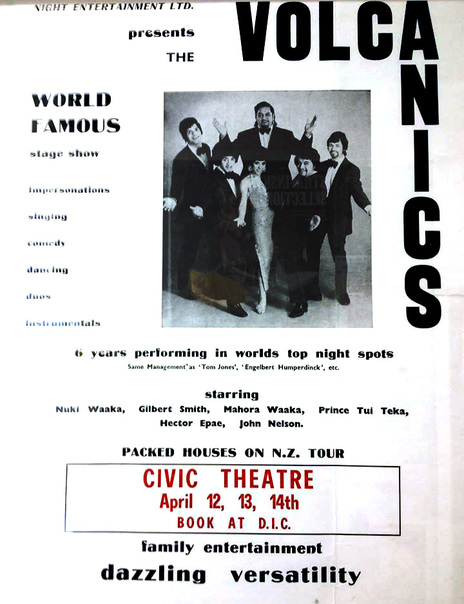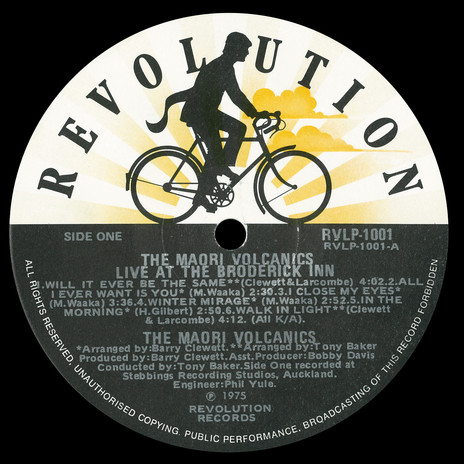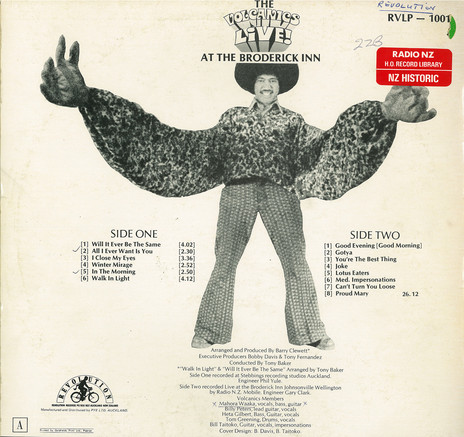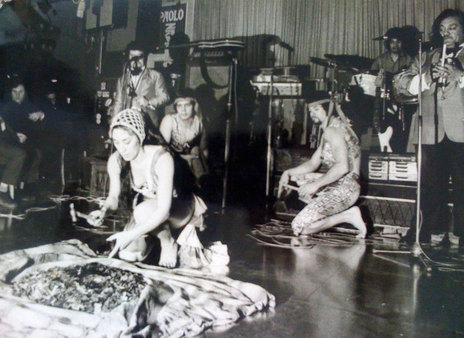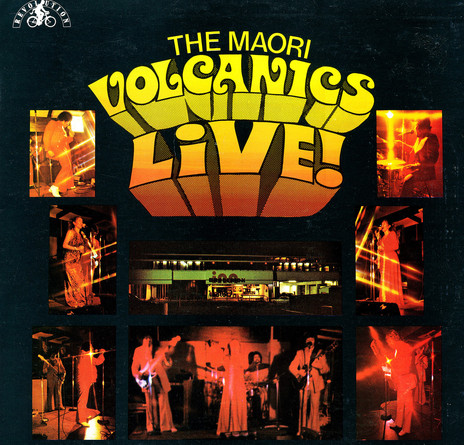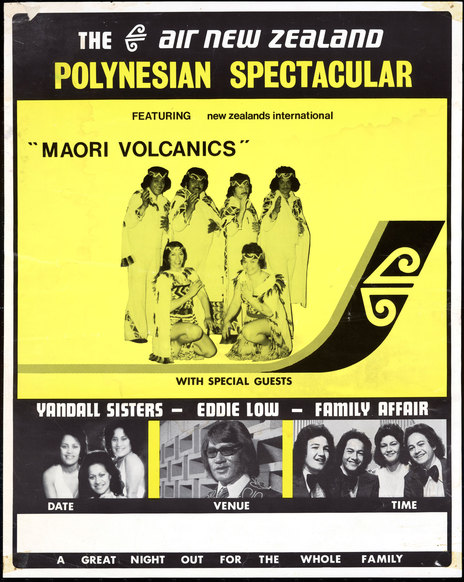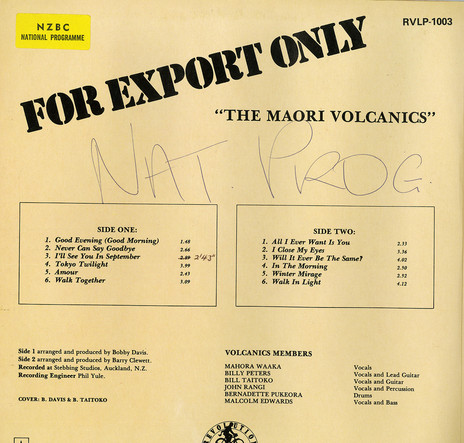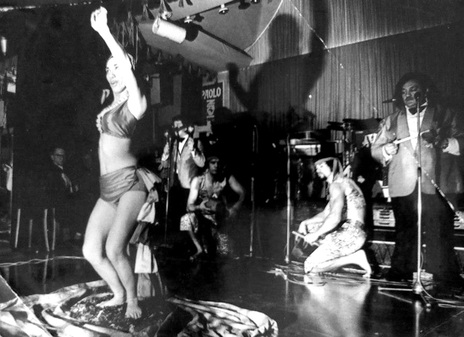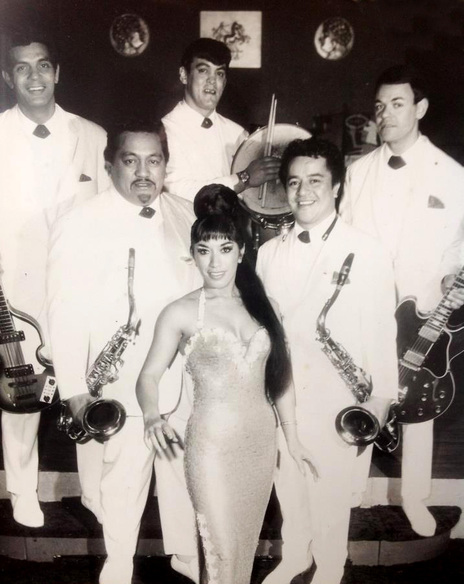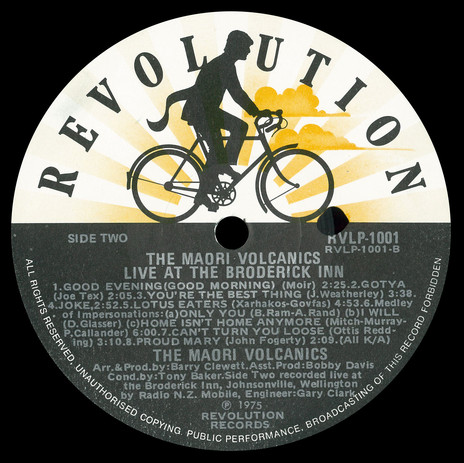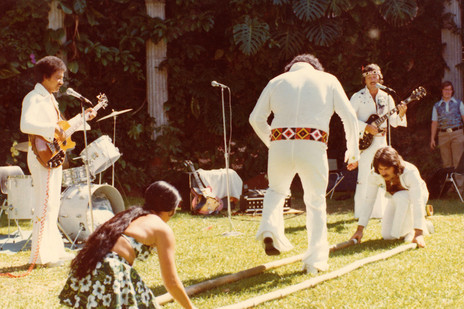She then mentioned an almost casual list of places the Māori Volcanics had played: “The Far East, Middle East, Europe, Great Britain, all through the States, Bermuda, Barbados …”
Had she been prone to bragging she might also have mentioned the international stars they encountered, were befriended by and sometimes performed with: singers Tom Jones, Engelbert Humperdinck, Solomon King and Dionne Warwick, the jamming with members of the Count Basie band, meeting actor Sidney Poitier …
“We didn’t have just one show,” said Peters, “we did all sorts of shows. We did country’n’western, we did calypso, we always did the Māori [music], never have we ever left that out … besides doing all the other stuff, the impressions, the comedy.”
From this distance and viewed through the lens of a world intimately interconnected by the internet, it can be hard to imagine how hard it was for artists in the 1960s and 70s working overseas in a time when a letter home was the norm and toll calls were rare.
In her 2005 autobiography Showband! Mahora and the Māori Volcanics, written with James George, Peters told of being in Bangkok in early 1967 when she learned by delayed letter that her father was desperately ill. In a panic phone call relayed through Hong Kong she heard beneath the static that he had died that morning.
“Two hours later I was onstage performing and no one knew (not even the boys) until after the show.”
The pre-history of the showbands and the Māori Volcanics – who formed in 1965 in Australia – was a confluence of artists, many of whom met at the Māori Community Centre in Auckland, found kindred spirits and left home for the brighter lights and better opportunities in Sydney.
Peters – from smalltown Whakapara in Northland – grew up on country music, popular light opera, early rock’n’roll and kapa haka. In 1955, age 16, she hitchhiked to Auckland where, after attending dances and practicing with poi, she heard the New Zealand Tourist and Publicity Department was putting together a Māori troupe to tour the country and then go to Australia.
She auditioned, was accepted and in 1957 was on the tour. Once back home she met and began a relationship with fellow musician Nuki Waaka; they subsequently married and had two children, she continued to perform in clubs and eventually the call of Australia became stronger.
Already showbands such as the Quin Tikis had established a reputation so Mahora, Nuki and his brother Gugi became the Polynesian Trio and played the clubs of Sydney alongside many other Māori artists including Tui Teka, Trevor Rupe (aka Carmen), the Kon Tiki Trio, the Māori Castaways, the Māori Premiers, the Hi Quins, the Māori Troubadours …
Members would often shift between bands and in 1965 the original line-up of the Māori Volcanics came together: Matti Kemp (lead guitar), John Clarke (aka The Gimmick) on drums, Nuki and Gugi on guitars, Hector Epae (vocals and impressions) and singer/dancer Mahora.
Their accumulated experience from touring and – in the case of Kemp and Clarke, other showbands – meant here was an outfit with breadth as well as depth.
Māori and Polynesian songs were added to the repertoire of standards and current pop hits.
Māori and Polynesian songs were added to the repertoire of standards and current pop hits, and Epae added more and more impressions as they went along (from Louis Armstrong to Yma Sumac is quite some stretch).
The work and opportunities came flooding in: four nights a week for 12 months in a Kings Cross club, then to Japan as the shipboard entertainment on the Oriental Queen, to Hong Kong (playing the Hilton), the Philippines (Manila Hilton, Subic Naval Base and other venues), Thailand performing for the royal family (unintentionally giving offense when the men performed an action song bare-chested) and where Peters learned a Filipino dance to add to their repertoire, Vietnam where they entertained American troops – and a few Kiwis – as the war was really heating up.
“We were performing at a base outside Da Nang on the back of a truck when the fighting broke out,” Mahora wrote in Showband! “Again without warning we were hustled into a foxhole, me still in my skin-tight sequined gown. Upside down I went with no apologies as helicopters flew overhead and the bombs fell dangerously close.”
They did a number of tours in Vietnam: “It was great experience,” Billy Peters told Piripi Walker on Radio New Zealand in 2005, “but we were doing 21 shows a week, so that’s three shows a day. In that heat. When you got on stage your uniform from the previous show was soaking wet already. Even if you had three uniforms you couldn’t keep them dry.
“So you went on in this cold, wet outfit,” he laughed.
But the rest of the world also beckoned: there were contracts with the Sheraton and Hilton hotels in Turkey, playing in Israel two weeks after the end of the Six Day War (meeting Danny Kaye who treated them to an impromptu haka), regular appearances over the years at US military bases in Germany (they also appeared in a half-hour German television production), Singapore again, and back home for a month in 1968.
Then they were off to Scotland and England (where Tom Jones came to catch their show which lead to a party afterwards and Jones’s management taking on the band for bookings). Then it was back again to Hong Kong, and on to Puerto Rico (where Peters had an operation for nodules on her throat and couldn’t speak or sing for a month).
So many more flights, hotels, venues and parties, and a revolving door of members. Gugi was the first to leave, before their international touring started. He was replaced by Paul Minhinnick of the Māori Troubadours, and the multi-talented and self-styled “Prince” Tui Teka (also of the Māori Troubadours) joined later also. All were talented performers who also learned on the job and were quick to adapt.
“That’s been the great thing about the bands like the Volcanics,” longtime member Billy Peters told Walker. “Because we had to walk in to an international audience, look at the people and we knew how to change our show effectively to suit these people. And it comes from being interested in people and loving working with people.
“You’re able to pick the cold spots and the hot spots in the audience, the ones you keep away from, which is the side that’s working great. But you could do that in an instant.”
Yet, as Kent Nixon in his book Pacific Stars and Stripes noted, “Everything they do has the air of casual improvisation about it, each performer has a solo spot and each displays a ‘take charge’ star potential”.
Showbands such as the Māori Volcanics were training grounds for talent and they had to keep their acts refreshed with current material as well as the popular standards and impersonations.
Mahora Peters learnt how to walk and dance on broken glass.
Mahora learnt how to walk and dance on broken glass (and to “wash” her face with it), and everywhere – as Nuki Waaka’s journal of notes and photos reproduced in Showband! attests – they were greeted with unanimous praise for their shows. These blended humour, hits and always included a Māori cultural and musical component, which most audiences were witnessing for the first time.
It became the band’s point of difference in the competitive world of cabaret and lounges.
Back home in 1971 they embarked on a 10-week farewell tour, during which Bryan Easte made an hour-long television special of their Wellington concert. It seemed that due to marriages and separations, road weariness and the feeling that things were winding down on personal levels the end was inevitable.
But it wasn’t. The following year Mahora and Nuki scouted for new members and in came drummer Billy Nuku; multi-instrumentalist Heta Gilbert from Tui Teka’s showband on sax, guitar and bass; Solly Pohatu (Māori Hi-Five vocalist) and Billy Peters (guitar, ukulele, mandolin). With female vocalists Marama Smith (who also played guitar) and Sonya Taylor, away they went again.
More touring, more line-up changes, another cabaret show, another residency, another city, another country: there were Playboy Clubs and times watching Count Basie, Mel Torme and the Commodores perform, then on to Hawai’i. In Tahiti they hung out with Jose Feliciano.
Nuki and Mahora separated, and he left the Volcanics to live at Surfers Paradise, forming the Māori Sky-liners with Rim D. Paul among others. Billy Taitoko James (Billy T James) joined in the mid-70s and honed his comedic craft watching British stand-ups who were their opening acts.
The road went on forever: 58 countries over 40 years.
The road went on forever – 58 countries and 40 years on the road, Peters believes – and in many ways the Māori Volcanics’ story didn’t end.
The group was the springboard for great talents – Prince Tui Teka, Billy T James, Robbie Ratana, Nuki Waaka, Billy Peters (Mahora’s second husband after Nuki), and Billy Nuku are just the most visible – and many of the members brought their skills back to this country and passed them on.
In 1975 the band released two albums, For Export Only: Highly Explosive, recorded at Stebbing’s in Auckland, and Live!, recorded at the Broderick Inn, in the Wellington suburb of Johnsonville. Apart from ballads and R&B, Live! featured Billy T James performing a range of impersonations.
There were reunions in Las Vegas and back home, television appearances, recordings, retrospective radio and TV documentaries. And memories passed into our whakapapa and cultural subconscious.
The Māori Volcanics took Māori culture to the world in an enjoyable entertainment package, they saw places few New Zealand artists have ever been – or would even want to go – and they brought back a wealth of experience, although sometimes not much else.
“We did very good business,” Peters told RNZ, “made some very good money. Always spent it of course, came back broke.
“We had a great time, but no money at the end of it,” she laughed.
--
Further reading: Showband! Mahora and the Māori Volcanics by Mahora Peters and James George (Huia, 2005)
--
Update: Nuki Waaka died on 27 November 2011.
